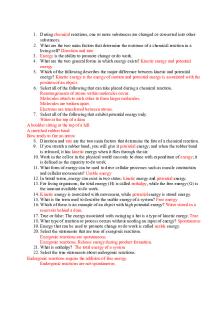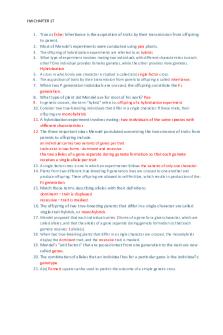Bio hw Ch 5 questions/answers with Professor Vladimir Poltoratsky PDF

| Title | Bio hw Ch 5 questions/answers with Professor Vladimir Poltoratsky |
|---|---|
| Course | Fund Of Bio Ii |
| Institution | St. John's University |
| Pages | 4 |
| File Size | 88.1 KB |
| File Type | |
| Total Downloads | 35 |
| Total Views | 158 |
Summary
Bio hw Ch 5 questions/answers with Professor Vladimir Poltoratsky...
Description
1. During chemical reactions, one or more substances are changed or converted into other substances. 2. What are the two main factors that determine the outcome of a chemical reaction in a living cell? Direction and rate 3. Energy is the ability to promote change or do work. 4. What are the two general forms in which energy exists? Kinetic energy and potential energy 5. Which of the following describes the major difference between kinetic and potential energy? Kinetic energy is the energy of motion and potential energy is associated with the position of an object. 6. Select all of the following that can take placed during a chemical reaction. Rearrangements of atoms within molecules occur. Molecules attach to each other to form larger molecules. Molecules are broken apart. Electrons are transferred between atoms. 7. Select all of the following that exhibit potential energy only. Water at the top of a dam A boulder sitting at the top of a hill A stretched rubber band Bow ready to fire an arrow 8. Direction and rate are the two main factors that determine the fate of a chemical reaction. 9. If you stretch a rubber band, you will give it potential energy; and when the rubber band is released, it has kinetic energy when it flies through the air. 10. Work in the cell or in the physical world can only be done with expenditure of energy; it is defined as the capacity to do work. 11. What form of energy can be used to drive cellular processes such as muscle contraction and cellular movements? Usable energy 12. In broad terms, energy can exist in two states: kinetic energy and potential energy. 13. For living organisms, the total energy (H) is called enthalpy, while the free energy (G) is the amount available to do work. 14. Kinetic energy is associated with movement, while potential energy is stored energy. 15. What is the term used to describe the usable energy of a system? Free energy 16. Which of these is an example of an object with high potential energy? Water stored in a reservoir behind a dam. 17. True or false: The energy associated with swinging a bat is a type of kinetic energy. True 18. What type of reaction or process occurs without needing an input of energy? Spontaneous 19. Energy that can be used to promote change or do work is called usable energy. 20. Select the statements that are true of exergonic reactions. Exergonic reactions are spontaneous. Exergonic reactions. Release energy during product formation. 21. What is enthalpy? The total energy of a system 22. Select the true statements about endergonic reactions. Endergonic reactions require the addition of free energy. Endergonic reactions are not spontaneous.
The products have a higher free energy than the reactants. endergonic reactions have a positive change in free energy. 23. What is the term used to describe the energy of a system that is available to do work? Free energy 24. All cells use a molecule called ATP to carry and release energy cyclically. 25. A(n) spontaneous chemical reaction will proceed without the input of energy. 26. Select all of the statements that correctly describe endergonic reactions. The products have higher free energy than the reactants. An input of energy is required. 27. Which of the following describes the hydrolysis of ATP? A water molecule is added to ATP resulting in its breakdown to ADP and inorganic phosphate. 28. A reaction is said to be endergonic when the addition of free energy from the environment is required for the reaction to proceed. 29. Chemical equilibrium occurs when the rate of formation of products equals the rate of formation of reactants. 30. What is the term used to describe the usable energy of a system? Free energy 31. What molecule is a common energy source for living organisms? ATP 32. True or false: When two reactions are coupled, the first reaction must always be exergonic for both to proceed exergonically. False 33. When a water molecule is used to remove a phosphate group from ATP, this is called the hydrolysis of ATP. 34. In general, enzymes are composed of proteins. 35. When does chemical equilibrium occur? When the rate of formation of products equals the rate of formation of reactants. 36. What is the main factor that can affect the rate of a reaction? catalysis 37. What is a substrate? A reactant molecule that binds to the active site of an enzyme. 38. When will an endergonic and exergonic reaction that are coupled proceed spontaneously? When the net free energy change for both reactions combined is negative (exergonic) 39. Enzyme-mediated chemical reactions take place when the substrate molecules bind to the active site of an enzyme. 40. Enzymes are typically composed of which type of macromolecule? Protein 41. What is Vmax? The maximal rate of a chemical reaction 42. What factors determine the direction and rate of a chemical reaction? Thermodynamics governs the direction of a reaction but not the rate of a reaction. The change in free energy will determine the direction of the reaction. Catalysts influence the rate of a chemical reaction. 43. Substrates, or reactants, are molecules that bind to an enzyme at the active site and are converted to products in chemical reactions. 44. What is KM? The substrate concentration at which the reaction velocity is half its maximal value 45. Where does a substrate bind on an enzyme in order for a chemical reaction to take place? Active site 46. Select the best description of product formation in enzyme-catalyzed reactions: Two steps: binding or release of substrate and product formation
47. Vmax is the maximal velocity or rate of a chemical reaction. 48. Altering the pH outside the optimal range for a protein can cause denaturation and can impair the function of an enzyme. 49. True or false: The enzyme concentration at which the reaction velocity is half its maximal value is the KM. False 50. Small molecules that are permanently attached to the surface of an enzyme and aid in its function are termed prosthetic groups. 51. Cofactors are small chemical components, usually inorganic ions, such as Zn2+, Cu2+, and Mn2+, that temporarily attach to the surface of an enzyme and promote a chemical reaction. 52. For an enzyme-catalyzed reaction, the formation of product can be viewed as occurring in two steps: (1) binding or release of substrate, and (2) formation of product. 53. Select the reasons why changes in the pH of the fluid in which an enzyme is dissolved affect the enzyme's ability to function. Enzymes have particular pH values at which they function best. 54. Which of the following is an accurate description of a coenzyme? Organic molecules that temporarily attach to an enzyme and promote a chemical reaction without being changed during the reaction 55. How can the functioning of an enzyme be affected by the external environment? Altering the pH can be harmful to an enzyme when the pH is outside the normal or optimal range for that enzyme. Increasing the temperature can greatly affect the functioning of some enzymes by causing denaturation. 56. What are prosthetic groups? Small molecules permanently attached to the surface of an enzyme that aid in enzyme function 57. At what temperature do most human enzymes function best? 37°C 58. What are the small chemicals, usually inorganic ions, that temporarily attach to the surface of an enzyme and promote a chemical reaction? Cofactors 59. True or false: Enzymes are sensitive to environmental conditions and, as a result, many enzymes function best only across a narrow range of temperature and pH. True 60. Increasing the temperature outside the optimal range for an enzyme can lead to denaturation of the enzyme, altering the enzyme's structure and function. 61. Coenzyme are small organic molecules that temporarily attach to an enzyme and promote a chemical reaction without being changed during the reaction. 62. Name environmental factors that affect proper enzyme function. Temperature, pH and ionic conditions 63. Many human enzymes function best at 37°C, which is: normal body temperature 64. True or false: Each step of a metabolic pathway is catalyzed by a specific enzyme. True 65. Why do most enzymes function maximally in a narrow range of temperature and pH? Exposing enzymes to temperatures and pH outside the optimal range can change the conformation of the active site or denature the protein. 66. How does temperature affect the functioning of an enzyme? Increasing the temperature outside the optimal range for an enzyme can alter the enzyme's structure and impair its function.
67. The two main functions of catabolic pathways are to recycle components of macromolecules and to produce energy intermediates, such as ATP, which are directly used to drive endergonic reactions in cells. 68. True or false: When an electron is added to a molecule, the molecule is oxidized. False 69. During each step of the metabolic pathway that adds phosphate groups to various sugars, a separate enzyme is needed to catalyze the reaction. 70. What are the two general functions of catabolic pathways? To obtain energy for use in endergonic processes To recycle the components of organic molecules for use in the synthesis of new molecules 71. Which of these is a synonym for anabolic reactions? Biosynthetic reactions 72. During the breakdown of small organic molecules, oxidation occurs when electrons are removed from an atom or molecule. 73. At what levels are metabolic pathways regulated? Cellular Biochemical Genetic 74. Anabolic reactions are also called biosynthetic reactions. 75. True or false: Cells can recycle macromolecules. True 76. The three levels at which metabolic pathways are regulated are (1) gene regulation, (2) cellular regulation, and (3) biochemical regulation. 77. What is the function of a protease? Protein degradation 78. The digestion of intracellular material, such as worn-out organelles, occurs by a process called autophagy. 79. Cells can recycle macromolecules, such as RNA and protein. 80. Enzymes that cleave the bonds between adjacent amino acids in a protein are called proteases. 81. What occurs during the process of autophagy in cells? Intracellular materials are digested by the lysosomes....
Similar Free PDFs

Ch 5 hw - ch 5
- 10 Pages

Ch. 5 Notes & HW
- 12 Pages

CH 5 HW: Nonverbal Communication
- 2 Pages

Bio Ch. 5 quiz review
- 2 Pages

HW Ch 1 - HW Ch 1
- 3 Pages

BIO 210 Macromolecules HW
- 6 Pages

Bio hw 7 photosynthesis
- 4 Pages
Popular Institutions
- Tinajero National High School - Annex
- Politeknik Caltex Riau
- Yokohama City University
- SGT University
- University of Al-Qadisiyah
- Divine Word College of Vigan
- Techniek College Rotterdam
- Universidade de Santiago
- Universiti Teknologi MARA Cawangan Johor Kampus Pasir Gudang
- Poltekkes Kemenkes Yogyakarta
- Baguio City National High School
- Colegio san marcos
- preparatoria uno
- Centro de Bachillerato Tecnológico Industrial y de Servicios No. 107
- Dalian Maritime University
- Quang Trung Secondary School
- Colegio Tecnológico en Informática
- Corporación Regional de Educación Superior
- Grupo CEDVA
- Dar Al Uloom University
- Centro de Estudios Preuniversitarios de la Universidad Nacional de Ingeniería
- 上智大学
- Aakash International School, Nuna Majara
- San Felipe Neri Catholic School
- Kang Chiao International School - New Taipei City
- Misamis Occidental National High School
- Institución Educativa Escuela Normal Juan Ladrilleros
- Kolehiyo ng Pantukan
- Batanes State College
- Instituto Continental
- Sekolah Menengah Kejuruan Kesehatan Kaltara (Tarakan)
- Colegio de La Inmaculada Concepcion - Cebu








